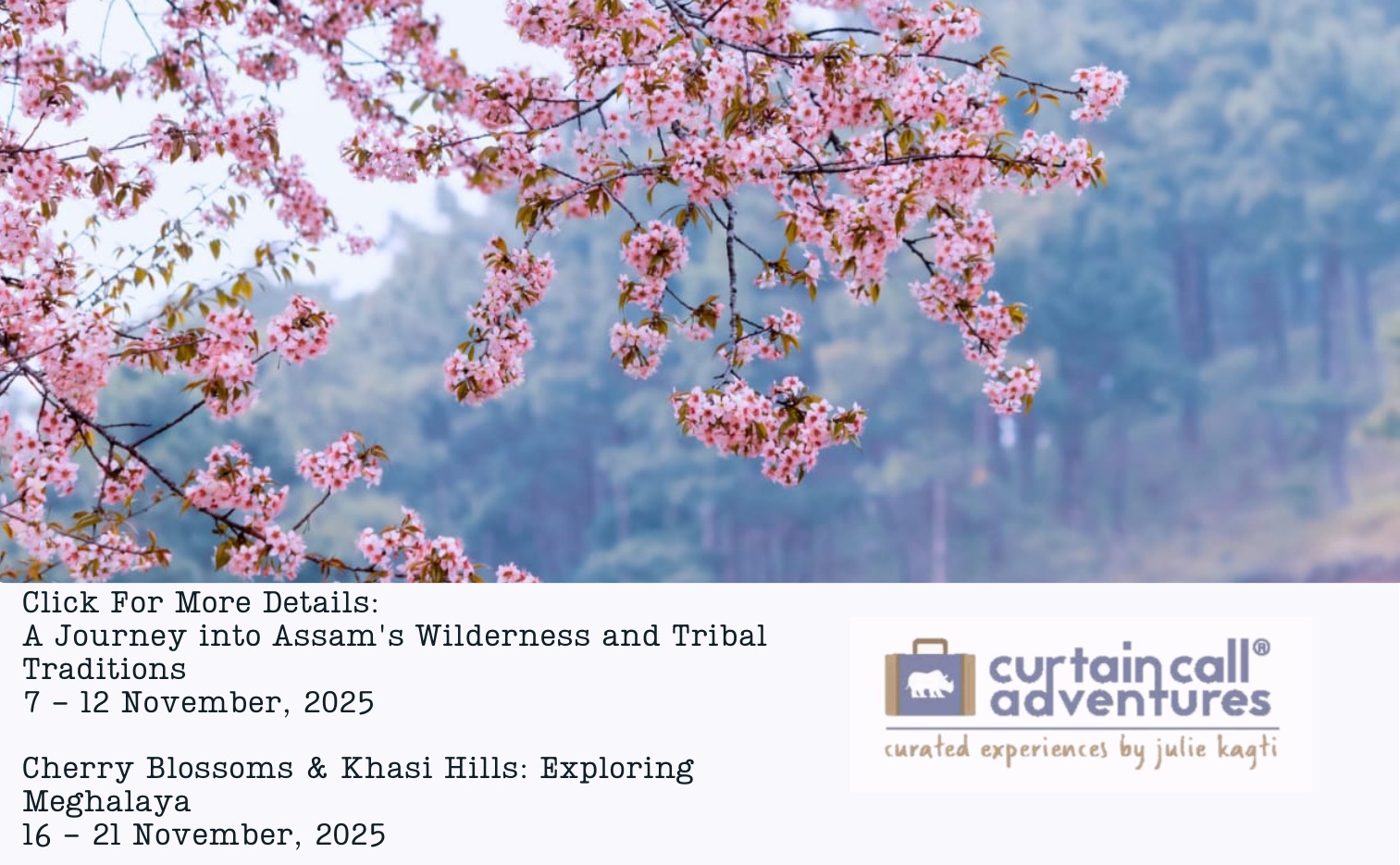It is early morning in Langban, the golden month of harvest in Manipur. The sky above Sagolband is streaked in soft hues of pink and silver, and the air carries a certain stillness, a gentle pause before something deeply sacred begins. Along the moat of Bijoy Govinda, the heart of Imphal begins to awaken. Women in traditional phanek gather with plates of flowers, fruits, and lamps; the scent of burning incense curls upward, mingling with the crisp autumn air. Somewhere in the distance, a conch shell sounds long, deep, and resonant calling devotees to the banks of the sacred water.
It is the eleventh day of Langban, the day of Heikru Hidongba, one of the most vibrant and spiritually charged festivals of the Meitei community of Manipur. Every year, on this very day, faith takes form not in temples or on altars, but upon the living waters in the rhythm of oars, the devotion of men, and the unity of an entire people.
*”Langban” in Manipur most refers to Langban Tarpan, a ritual for honoring ancestors, or Langban Heisoi Tamba, a related cultural event. These are Meitei traditions where “Langban” is associated with the lunar month of Langban (often August/September) and involves offerings and community gatherings.
Sagolband – constituency in Imphal West
Phanek-A phanek is a traditional wraparound skirt worn by the Meitei people of Manipur, India, as well as the Meitei diaspora worldwide. It is part of women’s clothing.
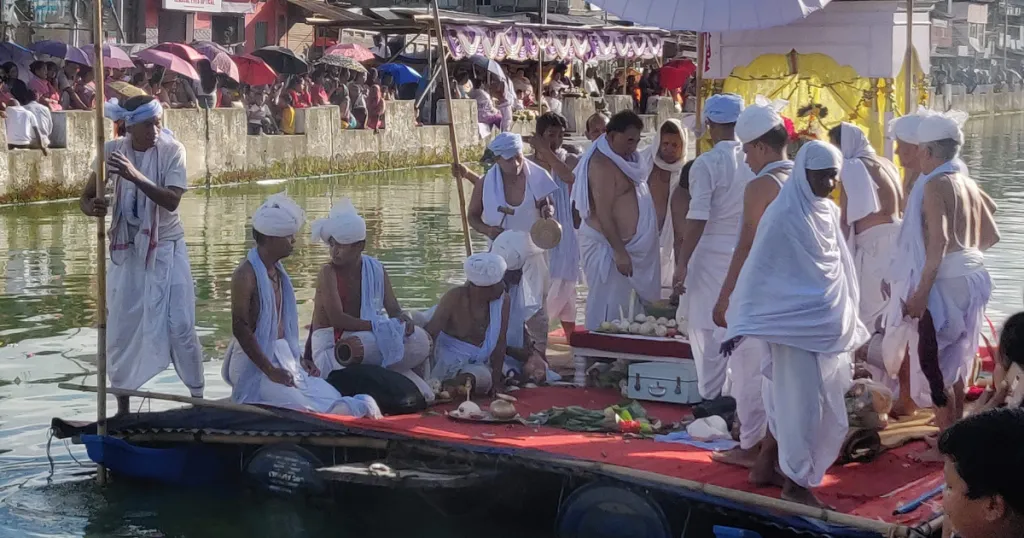
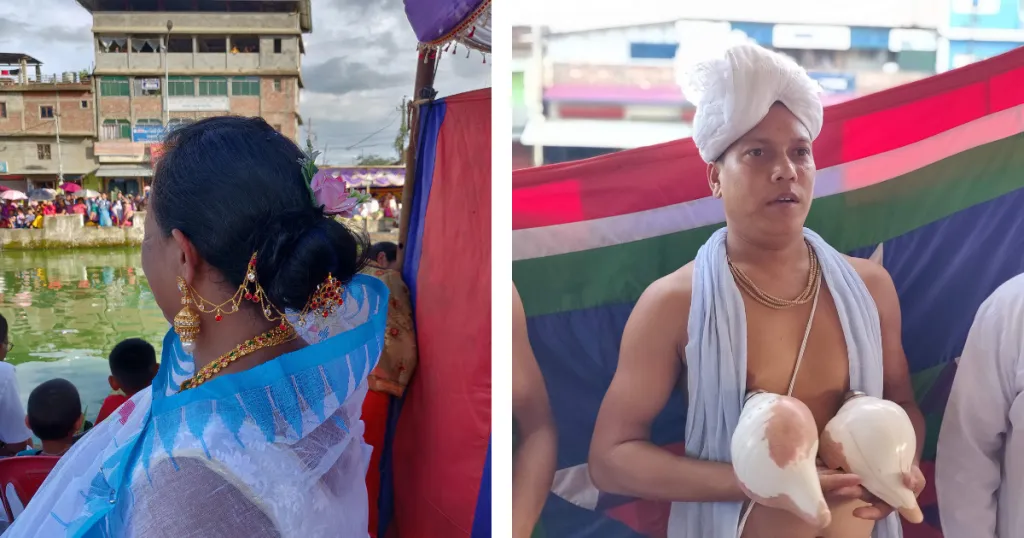
An Ancient Ritual with a River’s Memory
According to the Puya Lamlen Sakok, the roots of Heikru Hidongba stretch far beyond recorded time. Long before the age of kings and chronicles, it was celebrated as a ceremony to honour Sanamahi Pakhangba, the guardian deity of the household and protector of the land. The earliest known celebration dates back to the reign of Meiding-u Irengba in 984 A.D., when the festival had no fixed date. The king himself would decide an auspicious day to hold the ritual, a time when the people came together to pray for prosperity, strength, and peace.
Centuries later, during the reign of Rajarshi Bhagyachandra, the festival was reborn. Bhagyachandra, the visionary king who merged Meitei tradition with Vaishnavism, infused Heikru Hidongba with new spiritual and artistic depth. When he and his uncle Nongpok Leirikhomba began the worship of Shri Bijoy Govinda, the festival was revived in 1779 A.D. as a grand celebration of devotion and community. It was then decreed that the ceremony would henceforth be held every year on the 11th day of Langban, a tradition that continues unbroken to this day.
Through Bhagyachandra’s vision, the festival became not merely a ritual, but a living dialogue between faiths. Ancient Meitei elements such as the veneration of water, the worship of nature, and the symbolic offering of fruits were now joined by Vaishnavite rituals: the blowing of the conch, the chanting of sankirtan, and the offering of flowers and aarti to the divine. The moat of Bijoy Govinda became a sacred stage where myth, history, and devotion converged.
*Puya Lamlen Sakok is an ancient Meitei religious text (puya) from Manipur, regarded as a sequel to the Leithak Leikharol. Often called the Upanishad of Sanamahism, it blends mythology, philosophy, and history, tracing the spiritual and cultural evolution of Kangleipak. The word puya means “advice of the ancestors,” while Lamlen refers to a sacred philosophical path. The text preserves the Meitei worldview through myths, moral lessons, and accounts of their ancient kingdom.
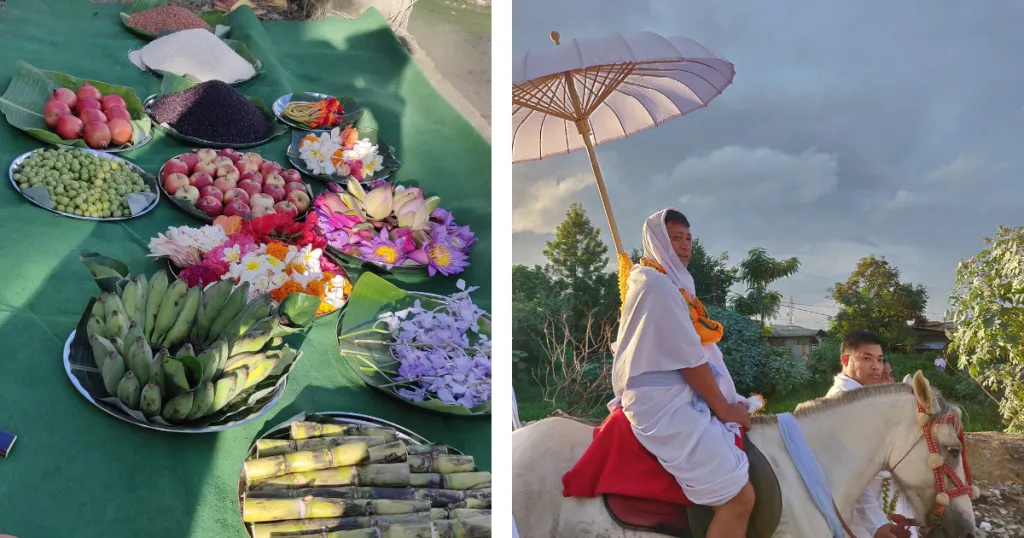
The Eve of the Festival: Offerings Before Dawn
On the eve of the festival, the moat becomes a theatre of preparation. Two majestic boats, their prows carved into serpent heads, rest silently by the bank. They are known as Hiyang Hiren — vessels believed to possess spiritual power. To the Meitei people, they are not just boats, but living embodiments of ancestral spirits, protectors against misfortune and evil.
Before sunrise, the two Tengmai Leppas — leaders of the competing teams — arrive at the temple of Shri Bijoy Govinda. Dressed in white robes, they carry gold and silver offerings in small vessels. Their steps are solemn, their faces calm, as they bow before the deity. The offering symbolizes the surrender of human pride to divine will, a ritual act affirming that no man rows alone; every stroke is guided by the grace of the divine.
Meanwhile, women gather near the banks to prepare two sacred garlands. One is made of 108 heikru fruits – the Indian gooseberry, believed to represent purity and inner strength. The other is made from 108 grains of rice, each grain painstakingly picked by hand. These garlands known as Heikru Pareng and Cheng Machang Pareng embody two truths: one that reflects the soul within, and another that honours the sustenance provided by the earth. Before the race, priests will decide which garland adorns which boat, guided by ancient signs and intuition.
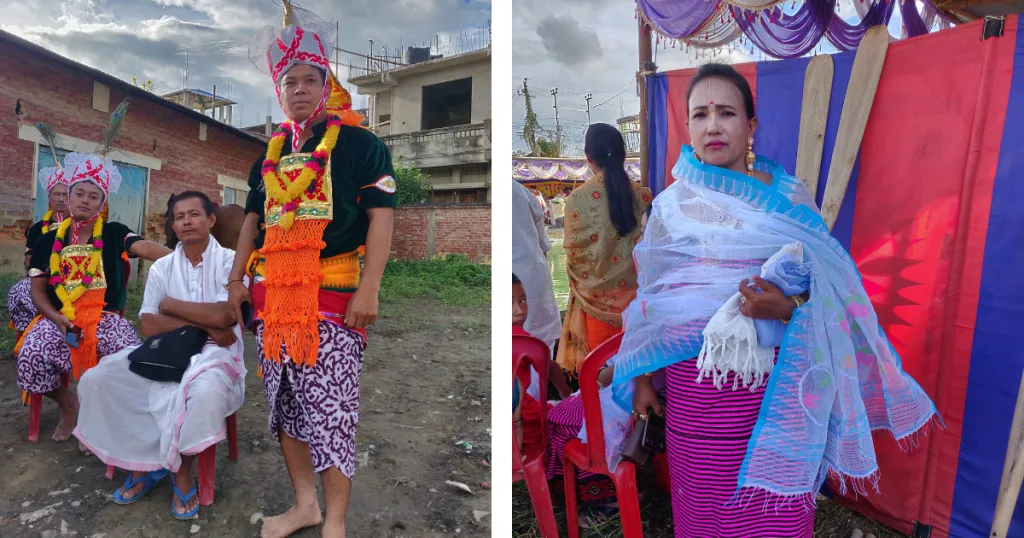
Lai Lamyengba: When the Lord Takes to the Waters
As the first rays of sunlight kiss the water, a hush descends over the crowd. From the temple emerges the idol of Shri Bijoy Govinda, beautifully adorned with flowers and jewels. The deity is placed on a special twin-boat called Khabak Lakpa, symbolizing divine presence upon the waters. The procession, known as Lai Lamyengba, begins.
The twin-boat glides slowly along the moat, led by priests chanting sacred verses and accompanied by the sound of cymbals and conch shells. At every Hiden (resting station), the boat pauses, and the devotees, standing along both banks, offer fruits, flowers, and burning lamps. The sight is breathtaking, shimmering light reflecting on water, the chants rising in rhythm with the oars, and thousands of hands folded in reverence. The air seems to pulse with energy, as if the entire land breathes in unison.
To the Meitei, this is more than a spectacle; it is a moment of communion. The water, the deity, and the people become one continuum — an eternal cycle of offering and blessing. When the procession reaches the eastern side of the moat, the priests perform aarti to Shri Bijoy Govinda, seeking peace and prosperity for all of Manipur.
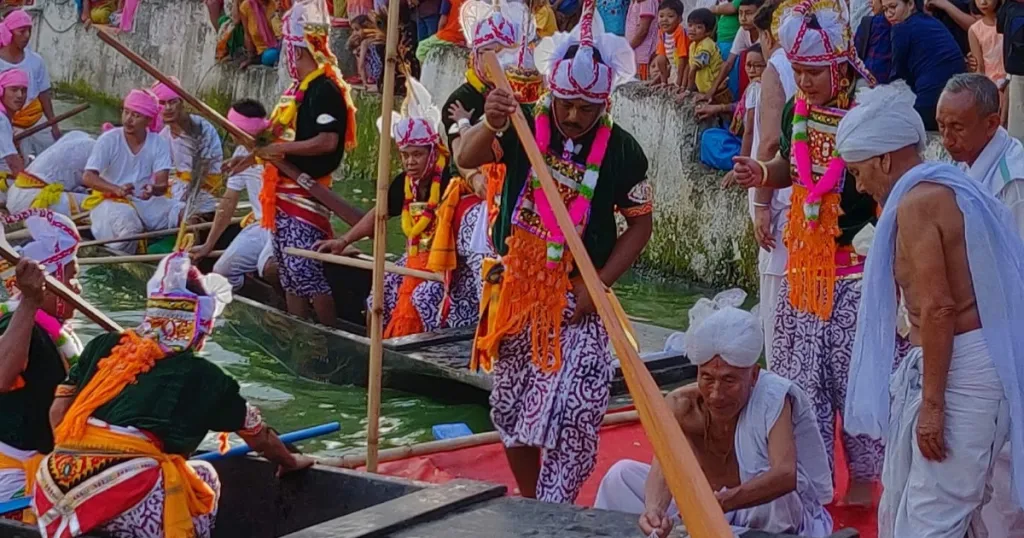
The Sacred Race: Hiyang Tannaba
After the divine procession, the mood shifts from solemnity to excitement. The time for Hiyang Tannaba, the sacred boat race, has arrived. Two boats, painted in vibrant red and yellow, are brought to the starting point. Their serpent-headed prows gleam in the sunlight; the rowers, clad in Ningkham, Shamjin, and brightly coloured Kokyet headgear, stand ready.
Each boat carries about forty to fifty rowers. The Tengmai Leppa, standing at the prow, commands the rhythm. Beside him are the Hinao Shaba, who steers; the Nourungba, who keeps the boat from flooding; and the Chang Shaba, who watches over the team leader. Every man has a role, every role is sacred.
Before the start, gold and silver coins are offered to the river as a gesture to appease the spirits of water. The conch blows once more, and the boats surge forward. The water churns into white foam, oars rise and fall like synchronized wings, and the air fills with the sound of drums and cheers. Along the banks, thousands of spectators clap, shout, and sing. The race is fierce, yet deeply ritualistic. It is said that the gods themselves watch from the clouds above.
As the boats near the finish line, anticipation ripples through the crowd. Victory is not merely about speed — it is symbolic of divine favour. When one boat crosses first, the priests declare whether it is the Heikru Pareng or the Cheng Pareng that has triumphed. The result, interpreted by the maibas (priests), is believed to predict the fortune of the year whether it will bring abundance, peace, or challenges to the land.
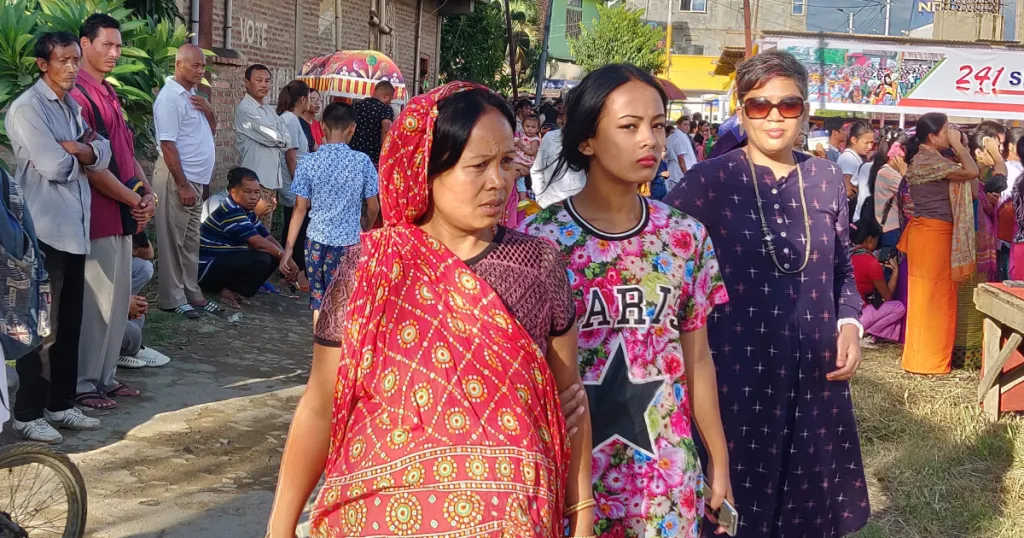
A Celebration of Unity
When the race ends, the moat erupts in jubilation. Songs are sung, prayers offered, and the winning team is honoured with the garland representing their victory. Yet there is no rivalry, no bitterness, only laughter and camaraderie. The festival is a celebration of oneness.
For centuries, the Heikru Hidongba has been a bridge uniting religion, caste, and creed. It brings together every household of Sagolband, every heart that beats for Manipur. Even the king and queen, seated in their special pavilion, participate not as rulers, but as devotees among their people. The sight of the crowd of farmers, priests, soldiers, children gathered shoulder to shoulder along the banks, embodies the spirit of harmony that defines this ancient land.
A quaint saying from olden times captures this essence:
“Hiyang Yenglingeida Tumbagi Sel Thourak-ee.”
It means, “While watching the boat race, someone reminds you to pay your debts.” It’s a gentle reminder that the festival is also a moment of reunion when friends, neighbours, and long-lost kin meet again, laughter mingling with devotion.
The Sacred Symbolism of Heikru
The fruit heikru, the Indian gooseberry, is at the heart of the festival. It represents the inner essence of human life, the purity of the soul. A curious tradition forbids anyone from eating the fruit before the celebration. It is said that doing so would cause one’s teeth to decay early, a superstition perhaps, but one that underscores the sanctity of the festival. Only after the race concludes, and the fruit has been offered to the Lord, may the people eat it.
Thus, the act of eating heikru becomes symbolic, a renewal of blessing, a shared act of gratitude to the divine for the gifts of the earth.
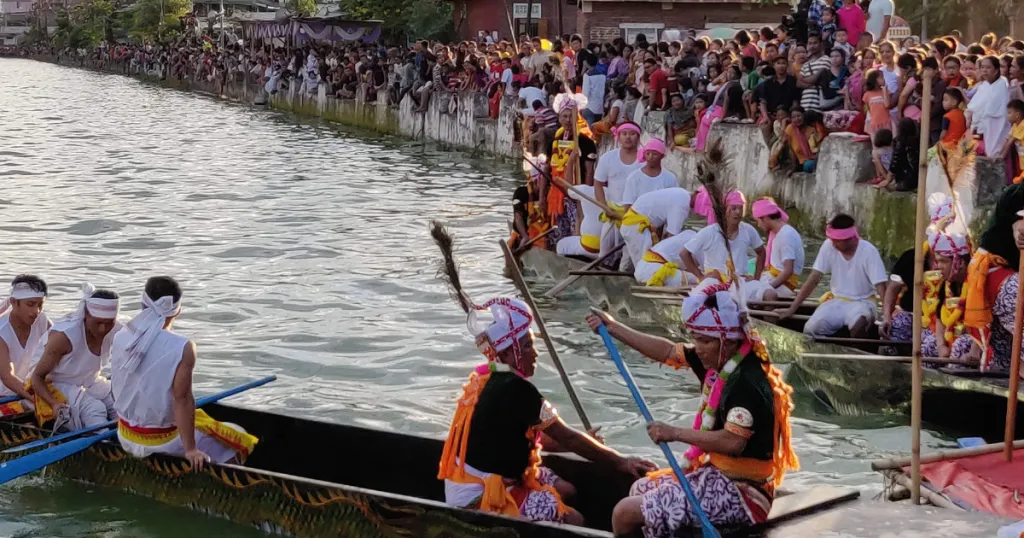
Echoes of History, Lessons of Faith
Behind the colour and cheer lies a story of resilience. Historians note that the Heikru Hidongba commemorates the unity of Manipur during times of great turmoil. When foreign invasions threatened the small kingdom, kings like Rajarshi Bhagyachandra found strength in divine faith and the solidarity of their people. The ceremony became both a prayer for protection and a celebration of national spirit, an affirmation that through devotion and unity, even a small kingdom could stand firm against the tides of adversity.
The festival thus embodies the moral philosophy of the Meitei people: courage balanced with humility, power tempered by devotion. It remains a living reminder of the words often spoken during the ceremony a message passed down through generations:
“Children of Mother Manipur, why do you look so downcast?
Your path to glory was opened by your noble-hearted ancestors.
Move onward — with the Lord in your heart,
and the footprints of your forefathers before your eyes.”

A Living Heritage
As the sun sets behind the hills, the idol of Shri Bijoy Govinda is carried back to the temple. Devotees sing bhajans, their voices mingling with the soft rustle of evening wind. Lamps are lit along the banks; their reflections tremble upon the water like memories that refuse to fade.
The boats are drawn ashore, their hulls still glistening with water and faith. The men who rowed them stand quietly now, their oars resting beside them. Around them, children laugh, elders exchange stories, and the air feels alive with something invisible: the pulse of tradition, the warmth of belonging.
To witness Heikru Hidongba is to see Manipur in motion, its faith, its history, its enduring heart. It is a reminder that culture is not confined to museums or manuscripts; it lives and breathes wherever people gather to celebrate life in reverence to the divine.
Each year, as the waters of Bijoy Govinda reflect the shimmer of garlands and lamps, Heikru Hidongba renews a timeless truth that the journey of faith is much like a boat race. The river may change, the oars may tire, but as long as hands row together and hearts beat as one, the race will go on guided by the unseen current of devotion.
And when the final conch echoes across the night, fading into the hills of Manipur, it carries with it not an ending, but a promise that the spirit of unity, courage, and love will continue to flow, generation after generation, like the eternal waters of the sacred moat itself.

